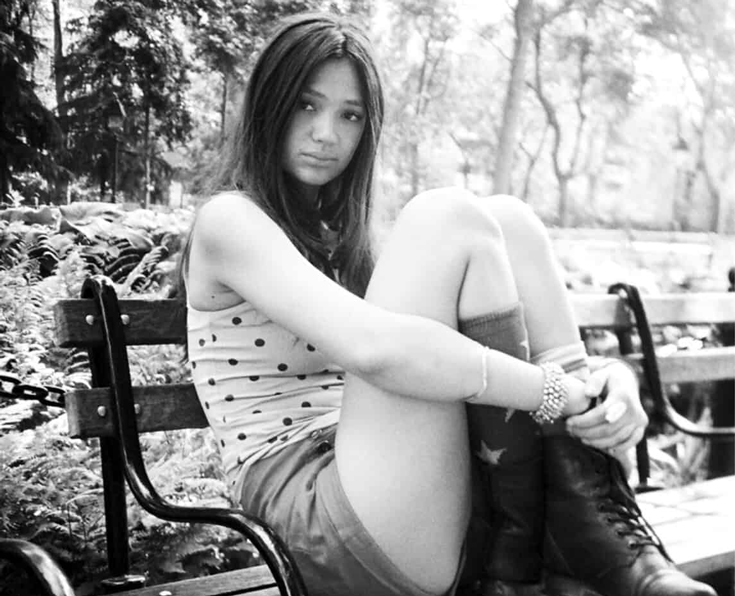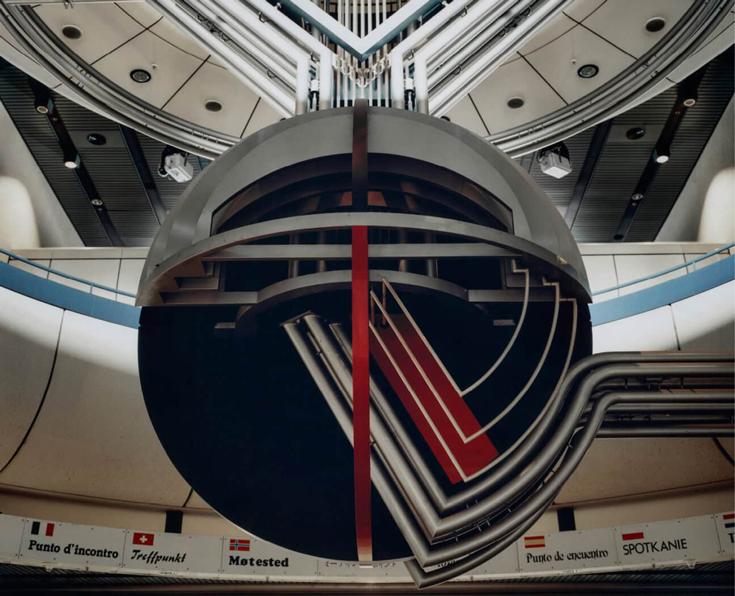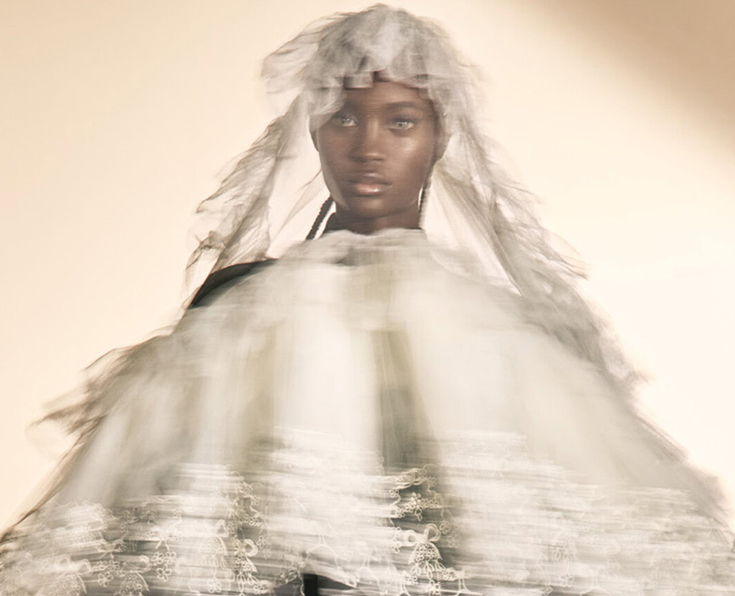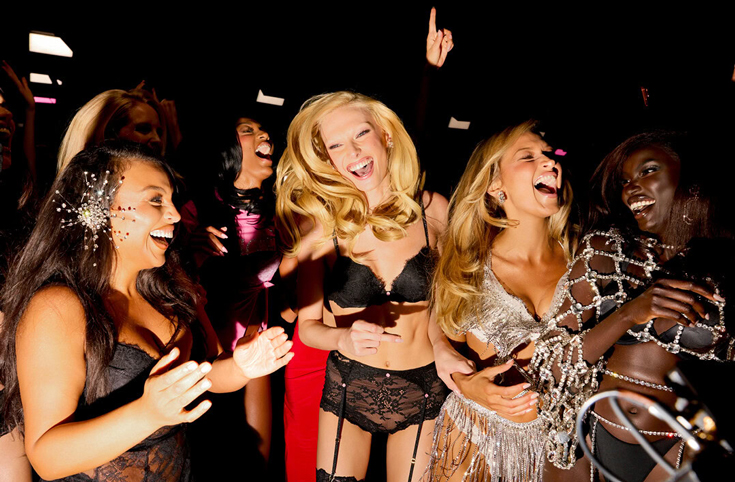THE PUNK POWER OF NOIR KEI NINOMIYA

Is it organic or unnatural? That’s always a question at Noir, where the designer Kei Ninomiya’s sculptural, fantastical pieces suggest a complex human relationship with the world around us. For all their magic, there’s often a feeling that the human is being consumed, augmented or colonised by their alien clothes. Who has the upper hand in the Noir dynamic? It swings from piece to piece.
For SS24 that tension could be seen in clothes that melded the sexuality and punk power dynamics of BDSM – straps, lace, leather, harnesses and hoods – with balletic tulle skirts and frothy rosettes of net that bristled with black dew-like droplets.
“I started the process with the key words ‘black and white’,” the designer explains over email from Japan. He then challenged his studio team to interpret it in their own way and incorporated the entire response into his collection. “I shared these words to my team and everyone started thinking and working on it. Black and white can have many different interpretations and approaches, which is why it is interesting to work as a team and see every individual come up with their own ideas of it,” he says. “This time we mostly worked on how to make the colour black stand out using the colour white, and how to create bigger expressions using small elements connected to each other.” For SS24, that meant metal suspender clips abstracted into rows of decorations or connected to form enveloping, cage-like constructions. Other pieces were made from wires hand- strung with black beads. “The ideas keep evolving as we create, and this is how the collection takes shape,” Ninomiya continues.

The craft that goes into a Noir piece is extraordinary. Each one often represents hundreds of hours of experimentation to find new techniques and ways of combining or using materials. He once made a collection without using a single stitch (dresses were held together with tiny studs) and always upends traditional ideas of luxury, using anything from silicone to metal and plastic alongside tulle, wool and silk. One twinkling black shrug looked like it was woven from strings of the night sky and sent into orbit around the body atop a pair of sturdy leather zip-front shorts. Another piece had strips of wired tinsel woven into a full-body cocoon, while what looked like strands of exploded alien DNA were draped to form the structure of a series of ballooning dresses. Some looks were recognisable as pieces of clothing – high-waisted black shorts held up with braces, a little cropped tailored jacket worn over an exploded white shirtdress. There were references to black-tie looks and Victorian babydolls, but everything was deconstructed into something altogether new.
Other pieces operated on the level of wearable, sculptural fantasies. One look was encrusted with black droplets that danced around the body on little wire strands, while another had the appearance of an upside-down white LED Christmas tree gone rogue and given the couture treatment. The models’ bodies were encased in cloud-like creations that were confounding and dizzying in their complexity and strangeness. What looked like branches were hand-threaded with black beads and spread into a network of leaf veins, where clusters of spongy black pollen gathered in a glorious chaos of wires and connections.
The kinky merged with the industrial or referenced nature at its most alien. If the Hubble telescope could design clothes, these constellation-like creations are what might result. The models’ Borg-like metal face jewellery only added to the “off- world” effect. It was mesmerising. The level of fantasy is so exalted at Noir that it’s impossible not to be awed by it. “It is hard for me to define creativity, but to put it simply, I am genuinely interested in anything that is new,” says the designer. “What drives me is the constant search for something new, to create something that people have never seen before. This ambition is always at the heart of my creation process.”


Ninomiya grew up in southern Japan, a bookish child of teacher parents. He would draw and use his imagination but he didn’t consider himself any more or less creative than those around him.
“I never thought of myself as a creative person, so there was no specific moment where I realised I could be a designer. However, even though I don’t see myself as a creative, I have always enjoyed making. I noticed my interest for creation when I was younger and kept developing it through the years without being fully aware of it.”
Fashion, however, had caught his eye. How could it not? An explosion of experimentation and creativity in the wider culture reverberated even in his hometown of Oita, which had a Comme des Garçons store in the 1980s. “Fashion in the 1990s was very strong in Japan – many subcultures were emerging and it was a strong tool of expression for the youth,” the designer recalls of his formative years. His exposure to fashion became even more intense when he went to study French literature at Aoyama Gakuin University in Tokyo. The Comme des Garçons store next to the university became a regular haunt, igniting his interest in Rei
Kawakubo and inspiring him to attend Antwerp’s Royal Academy of Fine Arts, whose alumni include Haider Ackermann, Demna, Diesel and Glenn Martens, Martin Margiela and the Antwerp Six (Ann Demeulemeester, Marina Yee, Dries Van Noten, Dirk Bikkembergs, Dirk Van Saene and Walter Van Beirendonck).
“Fashion is accessible to everyone, it is a way of expression that anyone can use and everyone can see. This is why I thought that it would be a good medium to try to create something new,” he says. At the Royal Academy he learnt “how to explore my creativity, as well as different creation techniques”. He dropped out in 2008, however, when, back in Japan for the summer break, he landed a job working as a pattern designer for Comme des Garçons. There, he flourished. “I could deepen my knowledge in pattern-making and explore new ways of expression,” he says. The novelty of his work so impressed Kawakubo that, in 2012, she suggested he show under his own name. He began staging private presentations at Comme des Garçons’ Parisian HQ at Place Vendôme and built a cult following of fashion insiders. Noir Kei Ninomiya made its official Paris catwalk debut during the AW18 show season, with the models wearing complex, exquisitely constructed all-black clothes, their faces covered by striking, triffid-like headpieces created in collaboration with the flower artist Azuma Makoto and made from live tropical plants – soil, roots, foliage, flowers and all. Ninomiya was 33 years old and told reviewers, “I use contrasting elements and things to make a new power… I want to make a new atmosphere, a new feeling.”


His intention hasn’t changed in the intervening years. With every collection, he says, it’s still his desire to provoke an emotional reaction. “It does not really matter how people feel about my work, as long as it sparks something positive in them. I want my creations to resonate in them, in whatever way.” For Ninomiya the best way to elicit that response is with a fashion show. “Every part of the process is important, from the design process to the production of the final pieces that will be sold in the stores. But to me, the fashion show is probably the most important since it is the first time that my creations are shown to the world.”
His catwalk shows are carefully crafted events. For SS24 we headed up through a car park in the 11th arrondissement to a disused industrial space, where the concrete catwalk was lit with rows of white strobe lights. The tiny space was packed to the rafters, with many editors standing on a ramp at the end of the catwalk to get a better view. The models stomped down the industrial runway on woven black platforms, a collaboration with the outdoors brand Keen, which will go down a storm with the Noir- heads, who obsess about what brand Ninomiya will partner with next. (Past collaborations have included Hunter wellies adorned with matching rubber BDSM harnesses, Church’s classic Shannon Derbies bedecked with safety pin clusters, and Repetto’s signature ballet pumps transformed into studded patent platforms.) Each look had different music, which glitched between exits – an audio echo of Ninomiya’s restless search for new expression.
It lives on in our imaginations, but not in his. Nostalgia is an emotion he is reluctant to indulge. Instead, the future holds all the romance. “After a collection is over I immediately move on and think about the next one. I cannot tell how I feel about SS24 any more since I am already thinking about what will come next!” The best is yet to come.
Taken from 10 Magazine Issue 23 – DARE TO DREAM – out now.
NOIR KEI NINOMIYA: INTO THE LIGHT
Photographer KASIA WOZNIAK
Fashion Editor SOPHIA NEOPHITOU
Sittings Editor GARTH ALLDAY SPENCER
Text CLAUDIA CROFT
Model NYAJUOK KUETH at Metropolitan Models
Hair SEBASTIEN BASCLE at Calliste Agency
Make-up MARION ROBINE at Calliste Agency
Manicurist MARIEKE BOUILLETTE at Calliste Agency
Photographer’s assistants TIMOTHY HACCIUS and GABRIEL LE GLAUNEC
Fashion assistant GEORGIA EDWARDS
Production ZAC APOSTOLOU
Location Studio Daguerre, Paris
Clothing throughout by NOIR KEI NINOMIYA, footwear by NOIR KEI NINOMIYA X KEEN











